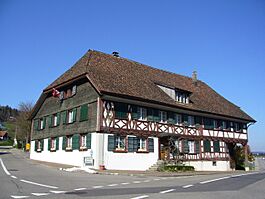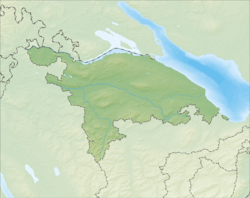Herdern facts for kids
Quick facts for kids
Herdern
|
||
|---|---|---|

The inn "Löwen", in Herdern
|
||
|
||
| Country | Switzerland | |
| Canton | Thurgau | |
| District | Frauenfeld | |
| Area | ||
| • Total | 13.73 km2 (5.30 sq mi) | |
| Elevation | 412 m (1,352 ft) | |
| Population
(Dec 2020 )
|
||
| • Total | 1,117 | |
| • Density | 81.35/km2 (210.71/sq mi) | |
| Postal code |
8535
|
|
| Surrounded by | Homburg, Hüttwilen, Mammern, Pfyn, Warth-Weiningen | |
Herdern is a town in Frauenfeld District in the canton of Thurgau in Switzerland. It's a small community with a rich history and beautiful natural surroundings.
Contents
Herdern's Past: A Look at History
Herdern was first mentioned way back in 1094. It was known as Harderin then. For a long time, it was controlled by a place called Ittingen.
Herdern Castle's Story
The local castle, Herdern Castle, was home to the Bettler family until 1403. Later, in 1501, the castle's land and legal rights joined to form the Herrschaft of Herdern. A Herrschaft was like a small territory ruled by a lord.
The castle was made bigger and updated in 1601. In 1683, the castle and its territory became part of the St. Urban monastery in Lucerne. A governor from the monastery lived in the castle and managed the area until 1798.
The monastery owned the castle until 1848, when it was sold. After a few different owners, it was bought by a group called the "Association of the Work Camps of Herdern." In 1895, they opened the castle as a home for people who didn't have jobs or a place to stay. By 1995, it became a home for people needing support with psychological and social problems. In 2003, about 75 people lived there.
Religious Changes in Herdern
The church area in Herdern was very similar to the Herrschaft lands. In 1331, the rights and taxes for the church went to the Kalchrain monastery.
When the Protestant Reformation arrived in 1529, some people in Herdern changed their religion. However, the local noble families stayed with the old religion. In 1533, Kalchrain sent a priest to support them. Because of this, the parish (church community) in Herdern remained Catholic.
How Herdern Earned a Living
Until the 1800s, Herdern's main ways to make money were growing grain, making wine, and producing fruit. These activities stayed important even after a cloth factory and a lignite (a type of coal) mine opened. Towards the end of the 1800s, raising livestock and dairy farming also became important in the village.
Herdern's Landscape and Land Use
Herdern covers an area of about 13.67 square kilometers (about 5.28 square miles).
What the Land is Used For
Most of Herdern's land is used for farming. About 67.4% of the area is farmland. Forests cover a large part too, about 28.1%. The rest of the land, about 4.5%, has buildings or roads. Only a tiny bit, 0.1%, is unproductive land.
Looking closer at the built-up areas, industrial buildings make up 2.1% of the total area. Homes and other buildings are 0.1%, and roads are also 0.1%. Parks and sports fields make up 2.2%.
For the forested land, 26.6% is dense forest. Another 1.5% has orchards or small groups of trees. Of the farmland, 63.9% is used for growing crops. About 3.4% is used for orchards or vineyards.
How Herdern Became a Municipality
Herdern is located in the Frauenfeld District. The current town was formed in 1998. It was created by combining the former "Municipal commune" (a type of local government) and the village of Lanzenneunforn.
Herdern's People: Demographics
Herdern has a population of about 955 people (as of 2000).
Population Changes and Languages
Over ten years (1997–2007), Herdern's population grew by 5.9%. Most people in Herdern speak German (95.5%). Albanian is the second most common language (1.7%), followed by French (0.6%).
In 2008, the population was almost evenly split between males (49.7%) and females (50.3%). Most residents are Swiss citizens. In 2008, the total population of Herdern grew by about 3.1%.
Age Groups in Herdern
As of 2009, Herdern has a good mix of age groups:
- Children (0-9 years old): 11.3% of the population.
- Teenagers (10-19 years old): 14.2% of the population.
- Young Adults (20-29 years old): 10.9% of the population.
- Adults (30-59 years old): These age groups make up a large part of the population, with 20.3% being 40-49 years old.
- Seniors (60 years and older): About 16.6% of the population.
Homes and Households
In 2000, there were 305 private households in Herdern. On average, there were 2.9 people living in each household. About 66.8% of households owned their homes.
Most of the buildings in Herdern are single-family homes (86.4%). There are also some two-family buildings and a few multi-family buildings. Many people live as part of a couple with children (58.3%).
Housing and Elections
In 2008, only about 1.12% of homes were empty. This means most homes were occupied. In 2007, 11 new homes were built for every 1000 residents.
In the 2007 Swiss federal election, the most popular political party was the SVP, receiving 43.22% of the votes. About 57.7% of eligible voters participated in this election.
Herdern's Population Over Time
Here's how Herdern's population has changed over the years:
| year | population |
|---|---|
| 1850 | 735 |
| 1860 | 792 |
| 1870 | 758 |
| 1880 | 733 |
| 1890 | 727 |
| 1900 | 741 |
| 1950 | 785 |
| 1960 | 730 |
| 1980 | 714 |
| 1990 | 852 |
| 2000 | 955 |
Important Heritage Sites
Schloss Liebenfels (Liebenfels Castle) is a very important historical site in Switzerland. It is listed as a heritage site of national significance. The area around Liebenfels is also recognized as part of the Inventory of Swiss Heritage Sites.
Herdern's Economy: How People Work
In 2007, Herdern had a low unemployment rate of 1.5%. This means most people who wanted to work had jobs.
Types of Jobs in Herdern
As of 2005, people in Herdern worked in different types of jobs:
- Primary sector: About 107 people worked in farming, forestry, and fishing. There were about 40 businesses in this area.
- Secondary sector: About 35 people worked in manufacturing and construction. There were 11 businesses in this area.
- Tertiary sector: About 113 people worked in services, like shops, schools, or healthcare. There were 23 businesses in this area.
Commuting for Work
In 2000, about 649 workers lived in Herdern. Many of them (about 45.5%) traveled outside Herdern for their jobs. At the same time, 93 people came into Herdern to work.
There were a total of 447 jobs available in Herdern (for at least 6 hours per week). For getting to work, 7.5% of people used public transportation, and 47.3% used a private car.
Religion in Herdern
Based on the 2000 census, the main religions in Herdern are:
- Roman Catholic: 41.4% of the population.
- Swiss Reformed Church: 41.0% of the population.
- Other Christian churches: About 4.19% of the population.
- Islamic: About 2.41% of the population.
Some people (about 7.43%) do not belong to a church, or are agnostic or atheist.
Education in Herdern
Education is important in Herdern. About 72.5% of adults (aged 25–64) have completed either advanced high school education or higher education, like university.
Local Schools
Herdern has its own primary school district, called Herdern-Dettighofen.
- Kindergarten: There are 25 children in kindergarten. The average class size is 12.5 students.
- Primary School: The primary levels start around age 5-6 and last for 6 years. There are 49 children in the lower primary level and 52 children in the upper primary level. The average class size in primary school is about 16.83 students.
See also
 In Spanish: Herdern para niños
In Spanish: Herdern para niños





